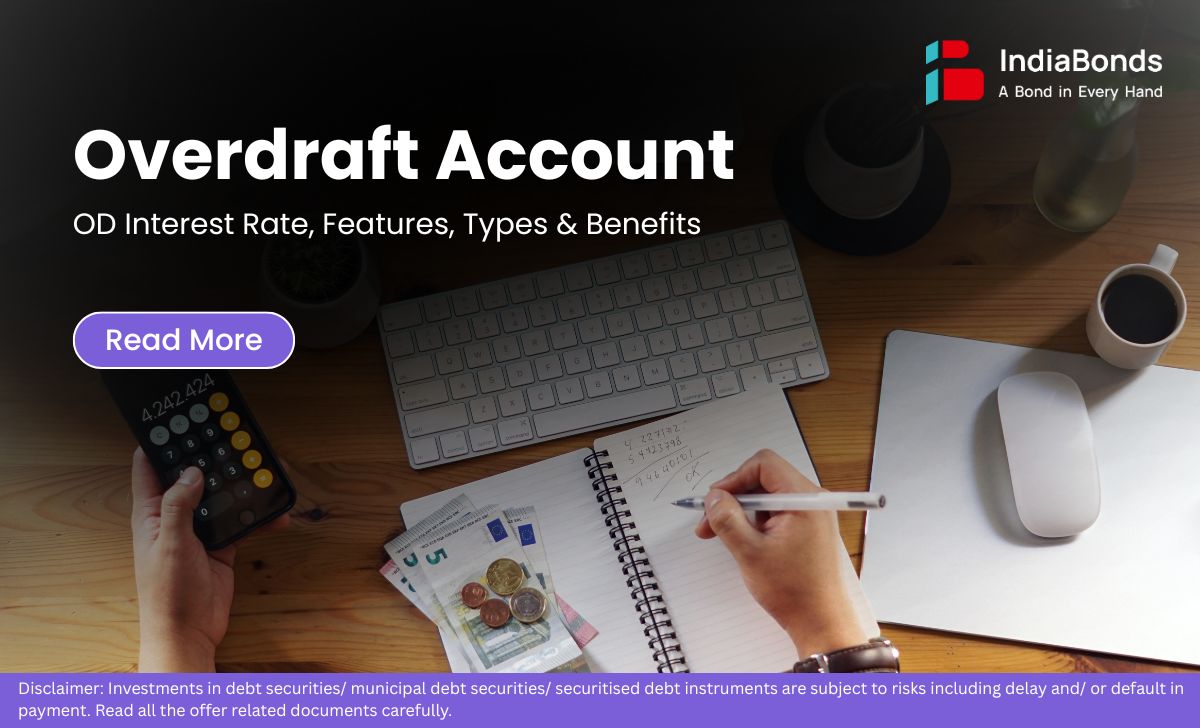Overdraft Account: OD Interest Rate, Features, Types & Benefits

An overdraft account lets a customer spend beyond the balance in a linked bank account, up to a pre-approved limit. It behaves like a ready credit line for short cash gaps—salary delays, supplier payments, medical bills, or seasonal working capital. When used with discipline, an overdraft account helps maintain cash flow without applying for a fresh loan each time. Interest is charged only on what is actually used and for the exact number of days used, which makes it a practical safety net.
Features
Banks sanction a limit after checking income, credit history, and collateral (if any). The customer can draw, repay, and redraw multiple times within that limit. Interest is metered daily on the utilized amount; unutilized limits don’t cost anything. Repayments instantly free up the limit again. Most banks provide internet and mobile banking access, cheques, and a debit card for seamless use. Fees may include processing charges or annual renewal. In simple words, the big benefits of overdraft are flexibility, speed, and interest only on usage.
Overdraft Facility – Interest Rate
The OD interest rate depends on the borrower profile, collateral, and the bank’s policy. For unsecured limits, the OD interest rate is usually higher than secured overdrafts; for secured ones (like against deposits), it is closer to deposit rates plus a small spread. Unlike term loans, interest on an overdraft account is calculated on the daily closing utilized balance and is billed monthly. Negotiating a realistic limit and keeping utilization low can reduce the effective cost. Always ask the bank for the annualized od interest rate and the full schedule of charges.
Pros and Cons of Overdraft
A quick view of the trade-offs before choosing an overdraft account.
| Pros | Cons |
| Pay interest only on the amount and days used | Can be costlier than a secured term loan if rates are high |
| Flexible draw and repay; no re-documentation | Easy access may lead to overuse and debt cycles |
| Useful for working capital or salary mismatches | Banks may review or reduce limits during stress |
| Improves payment reliability to vendors and utilities | Fees/renewal charges add to total cost |
Overdraft against Salary
Many banks offer a small, revolving overdraft account to salaried customers with a steady monthly credit. Limits are usually a multiple of monthly income and don’t require collateral. It covers month-end shortfalls, travel, or emergency spends. Repayment happens automatically when the next salary is credited, lowering the outstanding and interest. Keep utilization modest and close the dues quickly so the facility remains a buffer, not a habit.
Overdraft on Savings Account
Some banks permit a limited facility directly on a savings account, sometimes called a sweep OD. The limit may be linked to the average balance or a minimum salary criterion. It keeps transactions running—cheques clear, UPI or auto-debits don’t bounce—even when the balance dips temporarily. Because it sits on the primary overdraft account for day-to-day banking, monitoring becomes important; enable alerts so the drawdowns are visible and repaid early.
Overdraft against Time Deposits
This is one of the safest and most economical overdraft account options. The fixed deposit acts as collateral, and banks typically price the limit at the FD rate plus a small spread. There’s no need to break the deposit during cash crunches, so interest on the FD continues. Since the loan is secured, limits can be higher and documentation simpler. This is often the first choice for families or small businesses that want liquidity without disturbing savings.
(These three are the most common types of overdraft, though banks may have more variants for self-employed professionals and MSMEs.)
FAQs
How is OD interest calculated?
Banks compute interest on an overdraft account on the daily utilized amount, using the applicable rate divided by 365. The total for the month is billed, and any partial repayments during the month reduce the next day’s interest.
What is the difference between an overdraft and a term loan?
A term loan disburses once and is repaid in fixed EMIs. An overdraft is revolving—borrow, repay, and borrow again within the limit. Interest on a term loan applies to the full outstanding; OD interest applies only to the utilized portion.
Is an Overdraft better or a personal loan?
For short, irregular cash gaps, an overdraft can be cheaper because interest runs only on usage. For a one-time large expense with predictable repayment, a personal loan with fixed EMIs may offer lower rates.
What happens if I can’t pay my Overdraft?
The bank charges interest and penalties on overdue amounts, can freeze the limit, and may report delays to credit bureaus. For secured ODs, the bank may also adjust proceeds from the linked collateral.
Does applying for Overdraft affect my credit score?
Banks usually pull a credit report during assessment, and usage history is reported. Prudent use—low utilization and timely interest servicing—can support a healthy profile; chronic overuse can hurt scores.
Which type of account is a Bank Overdraft account?
Operationally it works like a current or savings account with an attached credit line. On the books, the utilized portion is a short-term borrowing.
Is a bank Overdraft a current liability or a long-term liability?
For individuals and most businesses, the utilized OD is treated as a current liability because it is payable on demand or within a short cycle, even when the facility itself is sanctioned for a longer tenure.
Disclaimer : Investments in debt securities/ municipal debt securities/ securitised debt instruments are subject to risks including delay and/ or default in payment. Read all the offer related documents carefully.
































